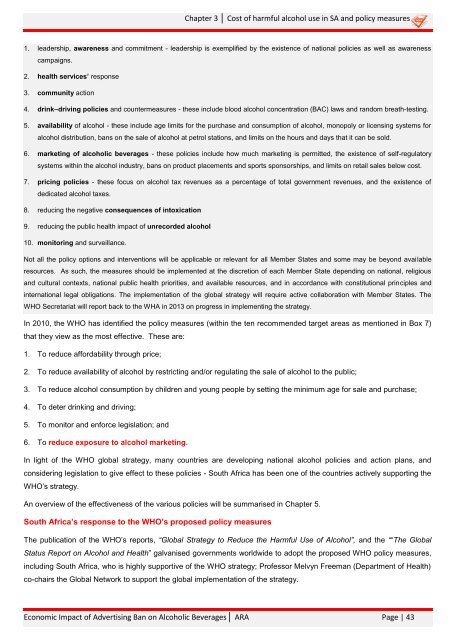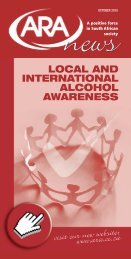CHAPTER 3 The cost of harmful alcohol use in South Africa ... - ARA
CHAPTER 3 The cost of harmful alcohol use in South Africa ... - ARA
CHAPTER 3 The cost of harmful alcohol use in South Africa ... - ARA
Create successful ePaper yourself
Turn your PDF publications into a flip-book with our unique Google optimized e-Paper software.
Chapter 3 │ Cost <strong>of</strong> <strong>harmful</strong> <strong>alcohol</strong> <strong>use</strong> <strong>in</strong> SA and policy measures<br />
1. leadership, awareness and commitment - leadership is exemplified by the existence <strong>of</strong> national policies as well as awareness<br />
campaigns.<br />
2. health services’ response<br />
3. community action<br />
4. dr<strong>in</strong>k–driv<strong>in</strong>g policies and countermeasures - these <strong>in</strong>clude blood <strong>alcohol</strong> concentration (BAC) laws and random breath-test<strong>in</strong>g.<br />
5. availability <strong>of</strong> <strong>alcohol</strong> - these <strong>in</strong>clude age limits for the purchase and consumption <strong>of</strong> <strong>alcohol</strong>, monopoly or licens<strong>in</strong>g systems for<br />
<strong>alcohol</strong> distribution, bans on the sale <strong>of</strong> <strong>alcohol</strong> at petrol stations, and limits on the hours and days that it can be sold.<br />
6. market<strong>in</strong>g <strong>of</strong> <strong>alcohol</strong>ic beverages - these policies <strong>in</strong>clude how much market<strong>in</strong>g is permitted, the existence <strong>of</strong> self-regulatory<br />
systems with<strong>in</strong> the <strong>alcohol</strong> <strong>in</strong>dustry, bans on product placements and sports sponsorships, and limits on retail sales below <strong>cost</strong>.<br />
7. pric<strong>in</strong>g policies - these focus on <strong>alcohol</strong> tax revenues as a percentage <strong>of</strong> total government revenues, and the existence <strong>of</strong><br />
dedicated <strong>alcohol</strong> taxes.<br />
8. reduc<strong>in</strong>g the negative consequences <strong>of</strong> <strong>in</strong>toxication<br />
9. reduc<strong>in</strong>g the public health impact <strong>of</strong> unrecorded <strong>alcohol</strong><br />
10. monitor<strong>in</strong>g and surveillance.<br />
Not all the policy options and <strong>in</strong>terventions will be applicable or relevant for all Member States and some may be beyond available<br />
resources. As such, the measures should be implemented at the discretion <strong>of</strong> each Member State depend<strong>in</strong>g on national, religious<br />
and cultural contexts, national public health priorities, and available resources, and <strong>in</strong> accordance with constitutional pr<strong>in</strong>ciples and<br />
<strong>in</strong>ternational legal obligations. <strong>The</strong> implementation <strong>of</strong> the global strategy will require active collaboration with Member States. <strong>The</strong><br />
WHO Secretariat will report back to the WHA <strong>in</strong> 2013 on progress <strong>in</strong> implement<strong>in</strong>g the strategy.<br />
In 2010, the WHO has identified the policy measures (with<strong>in</strong> the ten recommended target areas as mentioned <strong>in</strong> Box 7)<br />
that they view as the most effective. <strong>The</strong>se are:<br />
1. To reduce affordability through price;<br />
2. To reduce availability <strong>of</strong> <strong>alcohol</strong> by restrict<strong>in</strong>g and/or regulat<strong>in</strong>g the sale <strong>of</strong> <strong>alcohol</strong> to the public;<br />
3. To reduce <strong>alcohol</strong> consumption by children and young people by sett<strong>in</strong>g the m<strong>in</strong>imum age for sale and purchase;<br />
4. To deter dr<strong>in</strong>k<strong>in</strong>g and driv<strong>in</strong>g;<br />
5. To monitor and enforce legislation; and<br />
6. To reduce exposure to <strong>alcohol</strong> market<strong>in</strong>g.<br />
In light <strong>of</strong> the WHO global strategy, many countries are develop<strong>in</strong>g national <strong>alcohol</strong> policies and action plans, and<br />
consider<strong>in</strong>g legislation to give effect to these policies - <strong>South</strong> <strong>Africa</strong> has been one <strong>of</strong> the countries actively support<strong>in</strong>g the<br />
WHO’s strategy.<br />
An overview <strong>of</strong> the effectiveness <strong>of</strong> the various policies will be summarised <strong>in</strong> Chapter 5.<br />
<strong>South</strong> <strong>Africa</strong>’s response to the WHO’s proposed policy measures<br />
<strong>The</strong> publication <strong>of</strong> the WHO’s reports, “Global Strategy to Reduce the Harmful Use <strong>of</strong> Alcohol”, and the ““<strong>The</strong> Global<br />
Status Report on Alcohol and Health” galvanised governments worldwide to adopt the proposed WHO policy measures,<br />
<strong>in</strong>clud<strong>in</strong>g <strong>South</strong> <strong>Africa</strong>, who is highly supportive <strong>of</strong> the WHO strategy; Pr<strong>of</strong>essor Melvyn Freeman (Department <strong>of</strong> Health)<br />
co-chairs the Global Network to support the global implementation <strong>of</strong> the strategy.<br />
Economic Impact <strong>of</strong> Advertis<strong>in</strong>g Ban on Alcoholic Beverages│ <strong>ARA</strong> Page | 43




